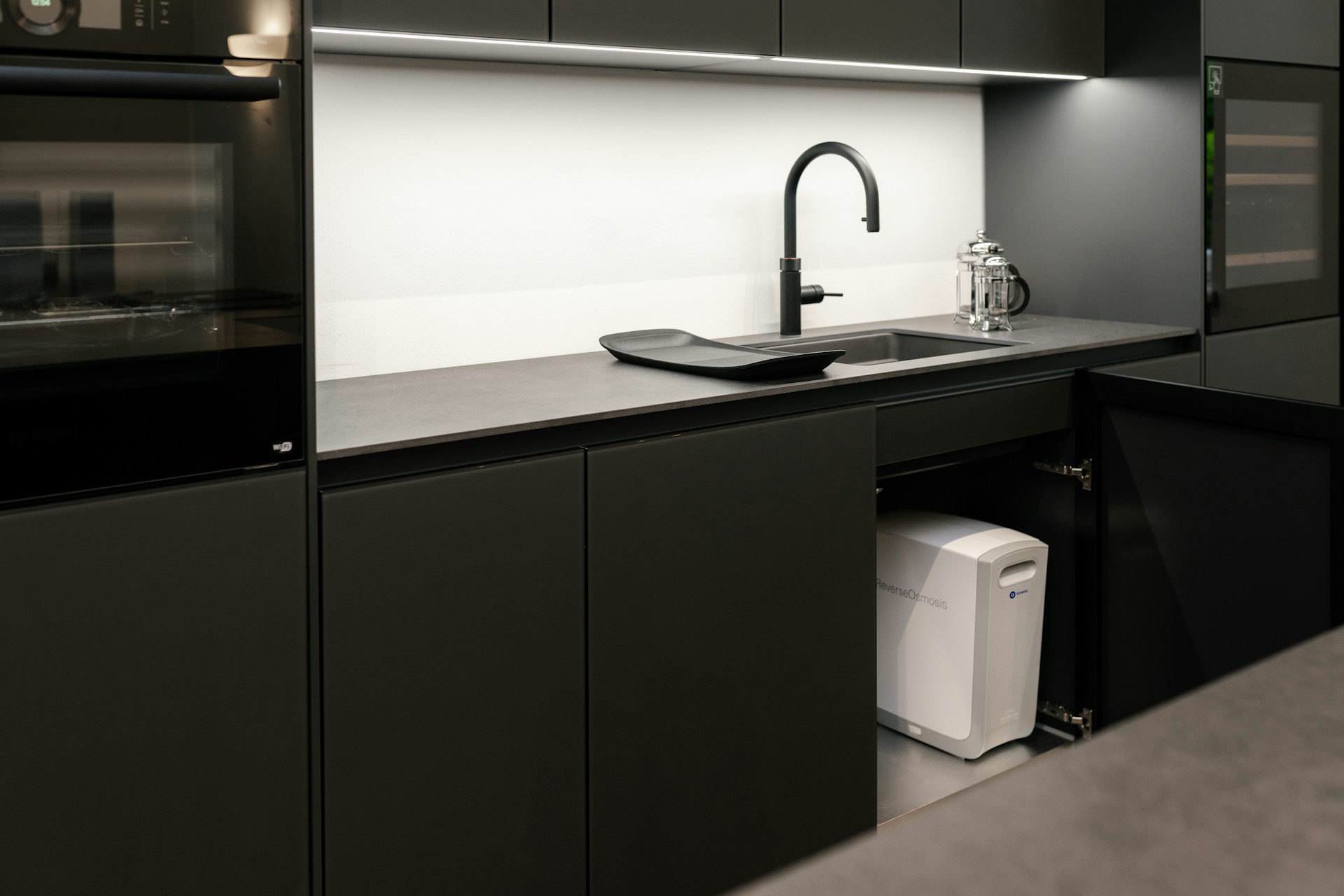PROPERTYSPARK ARTICLE
Expert Tips to Choose the Best Whole House Water Filter

What is a Whole House Water Filter?
One of the best ways of understanding a whole house water filter is by learning its other common name: point-of-entry (POE) filtration system. Unlike point-of-use filters that treat water at a single tap or appliance, POE systems install where your main water line enters your home, typically near your municipal water meter or jet pump for well systems. While installation requires professional plumbing work and adequate space, modern systems work seamlessly with your home’s existing water pressure and plumbing. Not every home needs a whole house filter — homes with good municipal water might only need basic point-of-use filtration for drinking water. POE systems, however, offer benefits for homes with specific water quality challenges. Following simple steps to help find a filter that meets their specific needs, homeowners can make a smart investment in both water quality and quality of life.
Why Choosing the Right Filter Matters?
Choosing a whole house water filter is not as much about personal preference, like shopping for a vehicle or home furnishings. The choice begins with understanding the water entering your home. Your water quality dictates the decisions you’ll make when selecting filtration methods, whether single filters or multiple-stage systems. Installing a carbon filter when you need sediment filtration, or opting for a three-stage system with water softening when you already have soft water, wastes both money and opportunity. The solution starts with a water quality report.
Understand Your Water Quality
Clean, safe water is essential, but what’s actually flowing through your pipes? Understanding your water quality is the first step in choosing the right filtration system. While municipal supplies meet safety standards, water quality varies widely. Private wells require individual attention. Additional filtration can address specific concerns about taste, odor, and impurities. Rather than guessing, smart homeowners start with understanding exactly what’s in their water.
Get a Water Quality Report
Your water source determines how to assess quality. For city and county water customers receive an annual Consumer Confidence Report (CCR) from their utility, as required by the Environmental Protection Agency (EPA). This document outlines your water source, detected substances, and how levels compare to EPA standards. Find your CCR online or request it directly.
Private wells, however, aren’t regulated by the EPA. The Centers for Disease Control and Prevention advises annual testing at a minimum. A certified laboratory can perform a comprehensive analysis looking for common well water impurities like coliform bacteria, nitrates, arsenic, and hard water minerals.
Identify Common Contaminants
Water impurities vary by location and source. Municipal water typically contains chlorine or chloramines for disinfection, affecting taste and odor. Hard water minerals like calcium and magnesium vex homeowners in many areas of the United States, creating efficiency-reducing scale. Well water often contains naturally occurring compounds causing stains and odors.
Both sources may contain sediment, dissolved metals, microplastics, and volatile organic compounds like trihalomethanes (THMs). While regulated in municipal water, many homeowners choose additional reduction. In fact, the EPA regulates an increasingly common chemical impurity called per- and polyfluoroalkyl substances (PFAS, aka “forever chemicals”). But only seven out of thousands of known chemicals are currently regulated, and scientists are only beginning to understand the range of health risks.
Match Filter Type to Contaminants
Your water report guides filtration choices. High sediment levels suggest starting with mechanical filtration. Hard water might require softening, while chlorine and organic compounds point to carbon filtration. Well water often benefits from UV treatment for microorganisms. The key is matching technology to actual needs, avoiding both inadequate and excessive filtration.
Types of Whole House Water Filters
The right filtration solution depends on your water quality and goals. Some homes need only a single filter type, while others benefit from a staged approach combining multiple filters. Understanding each type’s purpose helps inform your decision based on your water report and household needs.
Sediment Filters
Often your first line of defense, sediment filters reduce physical particles like dirt, rust, and sand that cloud water. These mechanical filters use micron ratings (1–100) to target specific particle sizes, protecting both water quality and appliances. They’re vital for well water systems and older municipal lines. A filter’s optimal micron rating depends on your specific water quality and a smaller micron rating is not necessarily better.
Reverse Osmosis Systems
While highly effective at reducing a wide range of impurities including dissolved solids, whole house reverse osmosis systems represent a significant investment that’s usually unnecessary for most homes. These sophisticated systems are typically recommended when water quality reports show specific challenges that simpler filtration methods can’t address effectively.
Carbon Filters
Carbon filtration excels at reducing chlorine, chloramines, and organic compounds affecting taste and odor. Available in granular and block forms with ratings from 0.5 to 10 microns, these filters improve water quality throughout your home. They often work alongside other filtration methods for comprehensive treatment.
UV Water Purifiers
Ultraviolet (UV) purifiers protect against harmful microorganisms using ultraviolet light. Especially valuable for well water or areas with known biological concerns, these systems work best after other filtration methods have reduced particles that could shield organisms from UV light.
Combination Systems
Many homes benefit from combining multiple filter types in sequence to address various water quality concerns. A common approach starts with sediment filtration, followed by carbon filtration for taste and odor improvement, with optional UV purification as a final step. Descaling filters or water softeners are also used in sequence on many homes. A combination approach provides customized treatment without unnecessary components.
Factors to Consider When Choosing a Filter
Beyond water quality, several practical factors influence filter selection. When properly chosen and installed, systems should deliver improved water quality without sacrificing pressure.
Water Flow Rate
When researching filters for your home, one of the first considerations is flow rate. Whole house water filters require a certain flow rate to ensure adequate pressure supply to the house to fill your faucets and run your large appliances. This is the reason you’re unlikely to find a whole house reverse osmosis system — the RO membrane reduces water flow too much. Most homes require 6-12 gallons per minute (GPM), with individual appliances needing 1.5-5 GPM.
Listed flow rates reflect clean filter performance; actual results vary with water quality. Look for low initial pressure drop numbers, indicating minimal system impact. Your filter’s flow rate should fall roughly within that of your source (and need not exceed the rate of supply), be it a well or city water system.
Filter Capacity and Longevity
A filter’s capacity is its lifespan — or how long before a filter loses its ability to do its job. A filter’s lifespan will vary with water quality and usage. Some homeowners set shorter, more aggressive, reminders to change their filters while others stick to manufacture recommendations or easy-to-remember cadences such as every 3, 6, or twelve months. While water continues flowing through expired filters in most installations, quality diminishes significantly.
Installation Requirements
Installation typically involves modifying pipes at your water source and requires adequate space for maintenance. Beyond filters and housing, you’ll need valves, fittings, and possibly specialized tanks. While experienced DIYers can manage installation, most homeowners benefit from professional installation — among other tasks, you’ll need the tools and ability to cut and deburr metal piping and solder new connections!
Maintenance Needs
Maintenance is another story. Once your point-of-entry system is in place and filtering water for your home, maintenance is fairly straightforward. Set filter replacement reminders based on your water quality and usage patterns. For example, sediment filters can build up sediment more quickly in some water supplies, but some sediment filters achieve optimal filtration with build-up, to a point. Similarly, a carbon filter will become saturated with the impurities it captures over time. And the salt in water softeners needs to be replaced. Check regularly for leaks and keep spare O-rings for filter housing. Simple maintenance ensures optimal performance and longevity.
Budget
The cost to install a point-of-entry filter will vary with the system, cost of labor, and complexity of the installation. Costs range from $1,000 to $5,000, averaging $2,500 installed. Consider ongoing filter replacement costs when budgeting. Buying filter value packs up front can provide savings, as filters can last for years in their original packaging. DIY installation of basic sediment and carbon systems can cost under $1,000.
The Bottom Line
Whole house water filtration is not needed in every home. Understanding your water quality report empowers you to make an informed decision about whether or not to install one or make changes to their existing system. By following these simple steps to match your home’s specific needs with the right system, you can make a more confident choice about improving your home’s water quality.
Learn how to Become a Top Agent with the Guaranteed 5 Min/Week System
No social media experience needed
Free webinar seat (limited quantities)
Learn the guaranteed 5 min/week system
Become a social media superstar
Constantly get new leads
Beat the competition
Get a special webinar deal
This Agent Tripled His Commissions Just With Social Media
Learn how this real estate agent tripled his commissions just with social media and how you too can become a social media superstar.
Why You Can’t Just “Boost” Your Real Estate Listing
That big blue button has tempted you before right? You want to Facebook Boost your Real Estate listing. Find out why you shouldn’t!
How Much Should Realtors Spend On Social Media
A question we get often from Realtors is “how much should I spend on social media?” Find out exactly how much to spend and how to spend it without getting ripped off!





